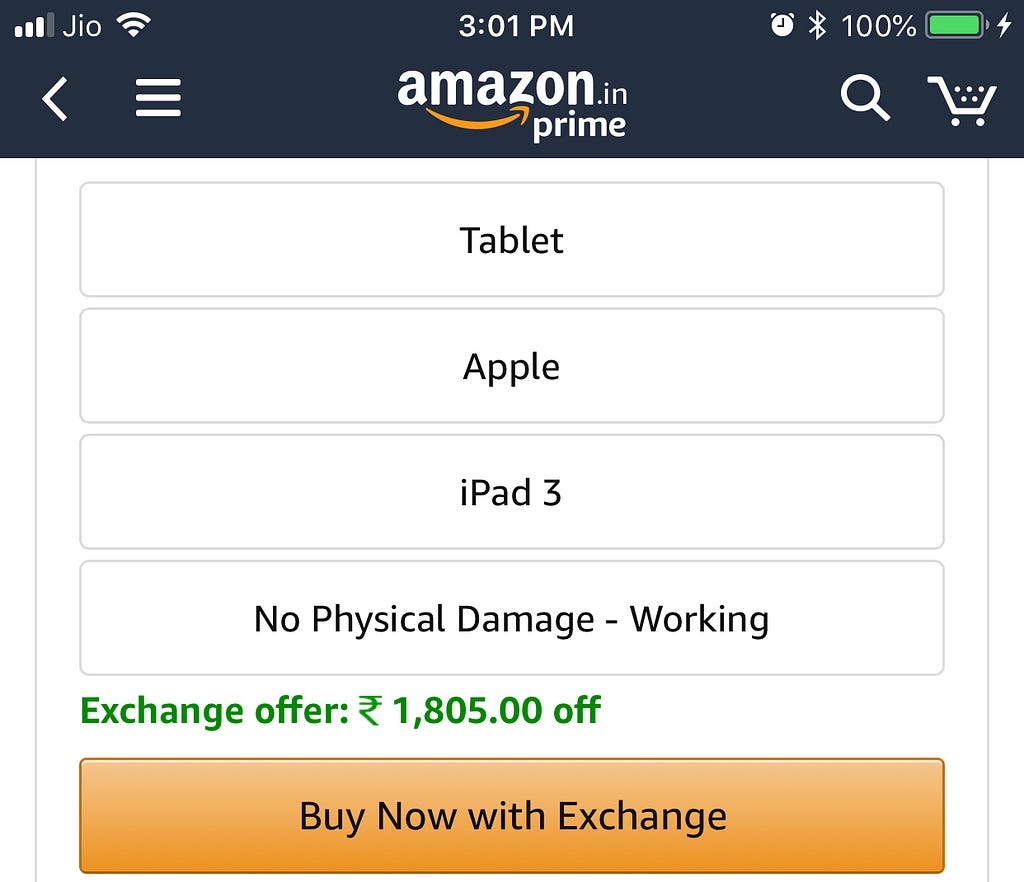Latest news about Bitcoin and all cryptocurrencies. Your daily crypto news habit.
iSad: an upgrade or ‘hang on’ dilemma
 Sitting on the fence for two years till Apple gave me a gentle push
Sitting on the fence for two years till Apple gave me a gentle push
I first felt the need to upgrade my iPad on Sep 13, 2016, the day iOS 10 launched. That was when I finally accepted that Apple wasn’t going to give any more OS upgrades for my iPad 3. However, there wasn’t anything really serious lacking in my iPad to justify upgrading to an expensive new iPad. Besides, my iPad and I have been together for six years now, and I didn’t feel good about breaking up with it. So I decided to hang on to it, till I got a good deal on the latest iPad model.
But this turned out to be a neverending cycle. The more I waited for a price drop, the closer I got to the launch of the newer iPad model, and the more I felt like waiting a bit longer for that model. But new models will always cost a bit more, which brought me back to square one. That’s how, nearly two years and another iOS later, I was still sitting on the fence with my iPad 3, waiting for the right moment to jump for an upgrade.
The device I didn’t want
The first time I laid hands on an iPad was when a friend got the original iPad in 2011. Seeing apps on that large screen was intriguing. But I couldn’t quite figure out how it would fit into my life. So I didn’t bother to get one. A few years later, in March 2012 to be precise, Apple launched its third generation iPad with the A5X chip and the then brand new iOS 5.1. Though it was theoretically the iPad 3, Apple simply called it the ‘New iPad.’ I saw that iPad a month later, displayed next to the iPad 2 at a mall, and its picture absolutely popped in comparison (2048x1536 @ 261 ppi vs 1024x768 @ 132 ppi).
The new iPad is dead; Long live the new iPad
I was instantly sold on it, and picked it up, in what marketer’s aptly term as an ‘impulse purchase.’ In November of the same year, Apple launched the 4th generation iPad. It came with a processor that was twice as fast, and the new lightning connector. In just seven months, my just launched ‘new iPad’ had become the old iPad.
Six years later, I still feel the pain. There’s an unwritten rule in the market which states that if you pay a premium price to buy a newly launched product, then you should be allowed to savour your status of having the latest version of that gadget for a certain period of time, which is usually around a year. Fortunately, Apple seems to have finally got the memo. There has never been another Apple product with as short a life cycle as the iPad 3.
My iPad finds its place
Anyway, after I purchased my iPad 3, I realised I had been right about wondering if I really needed it. My iMac with its 21" large screen was perfect for working, while my then iPhone 4 was my portable device. There was no a place for the iPad. Beside, typing on the iPad screen is inconvenient for anything more than a few minutes. I have tried using it with a bluetooth keyboard, and the small screen and low height still make it a pain, literally.
However my iPad slowly inveigled itself into my life. It was perfect for when I had work, but was forced to be away from my Mac for some reason. Its larger screen allowed me to type much faster and more easily than on my iPhone 4’s piddly 3.5" screen. It was also much better for reading, and surfing the net. After I had got used to the screen, I slowly began to use my iPad at home too. Like at breakfast, where it began to supplement the daily newspaper, partly because it was more updated on breaking news, and partly because I could follow more links on stories that I was interested in.
I did make one mistake though. I had gone for the iPad with a cellular connectivity. That turned out to be redundant as India’s cellular networks allow hot-spotting or sharing of your phone’s data connection. So I never did use a SIM in my iPad.
6 years old, and ready to retire
I have been using my iPad for six years now, and it’s slowly inching its way into obsolescence. Apple expects people to use its devices for 2–3 years max, and then replace them as technology advances make it hard for new software to run on older hardware.
My iPad 3 is a 32-bit device, and a lot of the 64-bit iOS and app features will not work on it. In fact, I heard Apple is discontinuing all 32-bit apps (or maybe has already discontinued them). So apps on my iPad 3 are often outdated and sometimes don’t exist. Besides newer OSes are designed for new hardware, and many features don’t work well or don’t work at all, on older hardware.
Like when iOS 9 was launched in September 2015, I happily installed it on my iPad. But to my horror, the new OS made my iPad sluggish. Like if I typed in a sentence, there would be a distinct lag before the typing appeared on screen. Or when I restarted my iPad, the screen would be visible, but take another minute or so before it would respond to my touch.
My solution was to erase the iPad, do a clean install of iOS 9, and put in only the basic apps. Safari and Mail are built in apps, and I use them often. I also downloaded Pages for writing, a couple of news apps, Skype, YouTube, VLC and a few other apps including the Medium app. With just these apps, the iPad seemed to run a bit smoother, though there was still was a lag in response.
Apple decides I need a gentle push
What made my iPad issues so obvious is that I own an iPhone 6S Plus, running iOS 11. My iPad on iOS 9 is not just slow but also misses a lot of the iOS 11 goodies. Things like live photos, ‘Airdrop,’ ‘Handover,’ the new notification and control centres, the night reading mode (Apple had removed Flux from the App Store even though it enabled night reading on older Apple devices, which was not a nice thing to do).
But what really made me decide that it was time to upgrade was this set of well-made videos by Apple. (Be warned, some apps shown are paid apps). Links to the other videos of this series can be found on the same page.
It made me realise what I was missing out by not upgrading, and also that the iPad 6 can do stuff my phone can’t. So when the 6th generation iPad was launched, I was definitely interested.
Is my iPad’s battery about to die? That’s straight from the horse’s mouth
That’s straight from the horse’s mouth
There was one last reason I decided to make the jump for a new iPad. From the above, it would seem Apple recommends replacing batteries which charge only up to 80% of their original capacity. After that, I assume battery performance will degrade and not be very predictable.
I used a free app called Battery Life (there are ads at the bottom) to check my iPad battery’s health. I had installed the app while doing a previous story on the right way to charge phone batteries.
It would seem my iPad’s battery health is down to the danger level of 80% wear though it hasn’t yet touched 500 cycles. I assume the age of the iPad (6 years) has added to its wear level. Basically, from this point on, any additional time I get on my iPad is a bonus, and not guaranteed by Apple. Yup, time to move on.
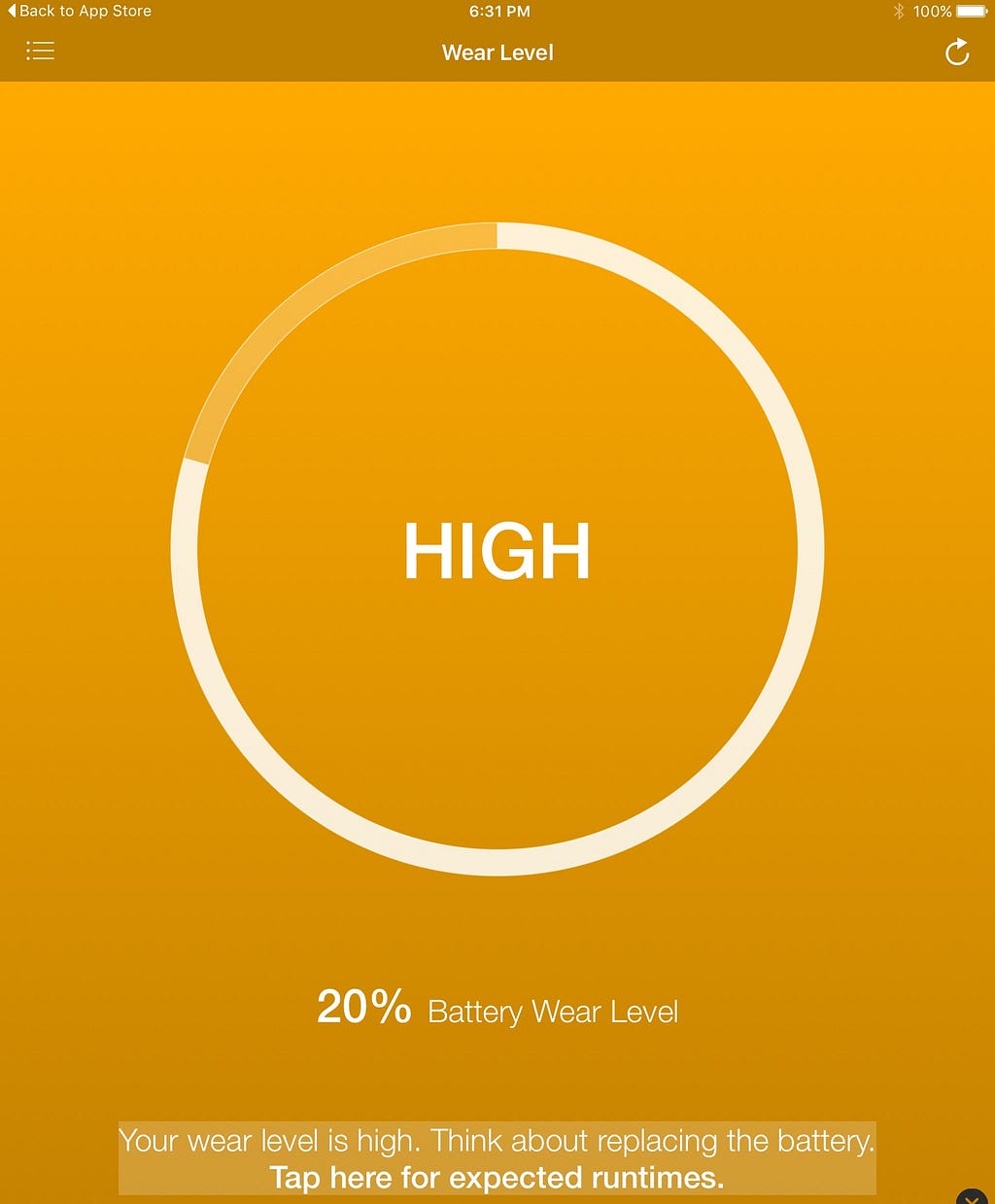
 20% wear level at 492 charge cycles - battery performance can be expected to start degrading fastHobby horse vs Workhorse
20% wear level at 492 charge cycles - battery performance can be expected to start degrading fastHobby horse vs Workhorse
We would all like to own Ferraris but end up with a car in our budget. My iPad was no different. I wanted the 12" iPad Pro but was it overkill for my needs? I’m no artist and my iPad will be mostly used for surfing and viewing media and a bit of writing. In fact, I usually do most work related stuff, including this post, on my Mac. So a bit of research seemed in order.
The above reviewer made a lot of sense to me. He’s an artist who owns an iPad Pro, which he uses as a work horse. His earnings from work done on his iPad Pro is several times more than what he spent on it, which was around $1400. He believes the iPad 6 is Apple’s best ever value-for-money device, and more than enough for student artists who may not yet be generating much of an income. As my use of an iPad will be even less than that of a student artist, this argument definitely applies to me. So I finalised on the iPad 6, and decided to hold off on Apple Pencil. And yes, I’m aware its Retina Display is the same as my six year old iPad 3. The only thing left was to look out for the right time to buy it. This would basically be when the big online retailers had a sale going.
Price Surprises
Price is an issue in India as Apple products are generally prohibitively expensive here. That’s because the Indian government imposes heavy taxes on products made outside India. This is in order to encourage local investment by those foreign companies. For instance, the 6th generation iPad costs $329 (₹22,375) in the US Apple store, but was selling for $412 (₹28,000) in Amazon India (Apple Stores are not present in India).
In mid April, Amazon had a sale, and I managed to get the iPad for $360 (₹24,499) by buying it then. An offer on my credit card knocked ₹1500 off the sale price of ₹25,999. But it still cost $30 (₹2,040) more than in the US.
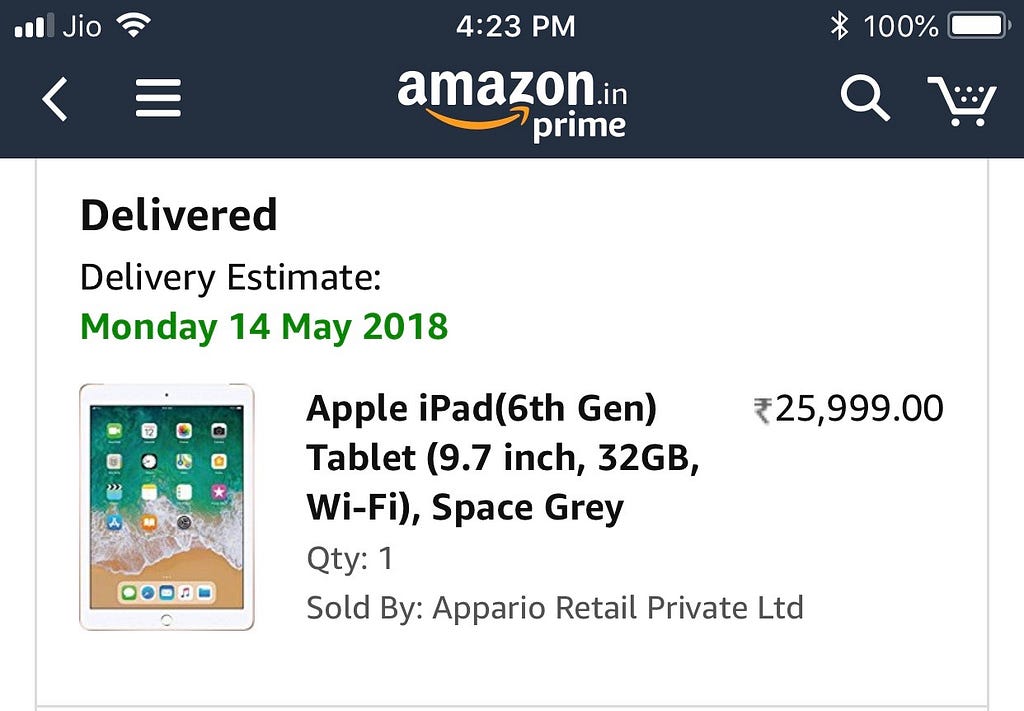 An offer on my credit card knocked a further ₹1500 off but it’s stil $30 more than the US price
An offer on my credit card knocked a further ₹1500 off but it’s stil $30 more than the US price
If I had waited a few months, I may have probably got a better deal, but like I said, it’s a neverending cycle of price drop vs latest tech. So I went ahead and ordered the iPad 6. I recall $397 (₹27000) for my iPad 3 six years ago, but that’s not too surprising as prices drop when technology advances.
India may have the world’s least expensive iPhone
There’s another angle to prices in India. When Apple finally accepted that India is a price sensitive market, they decided to test things by assembling the iPhone SE locally. This got around the tax issue, and the difference is startling. The made-in-India iPhone SE can be bought in India for $279 (₹19000), while it costs $349 (₹23,735) in the US. That’s substantially cheaper.
Unfortunately, Apple has not yet been able to do this for other iPhone models or iPads. Also, there is a very limited demand for 4" screen phones in the Indian market where 5.5" screens is the standard in the iPhone SE’s price range. My wife is one of those who opted for this phone, probably because she was upgrading from a 3.5" iPhone 4. If you are okay with the screen size, I can confirm the iPhone SE is a real bargain. It has the same internal hardware as my iPhone 6S series and runs the latest iOS 11 as fast and as smooth as on my far more expensive iPhone 6S Plus. In fact, you can get it for ₹17000 ($249) if you plan your buy like I did during a sale by the giant online retailers.
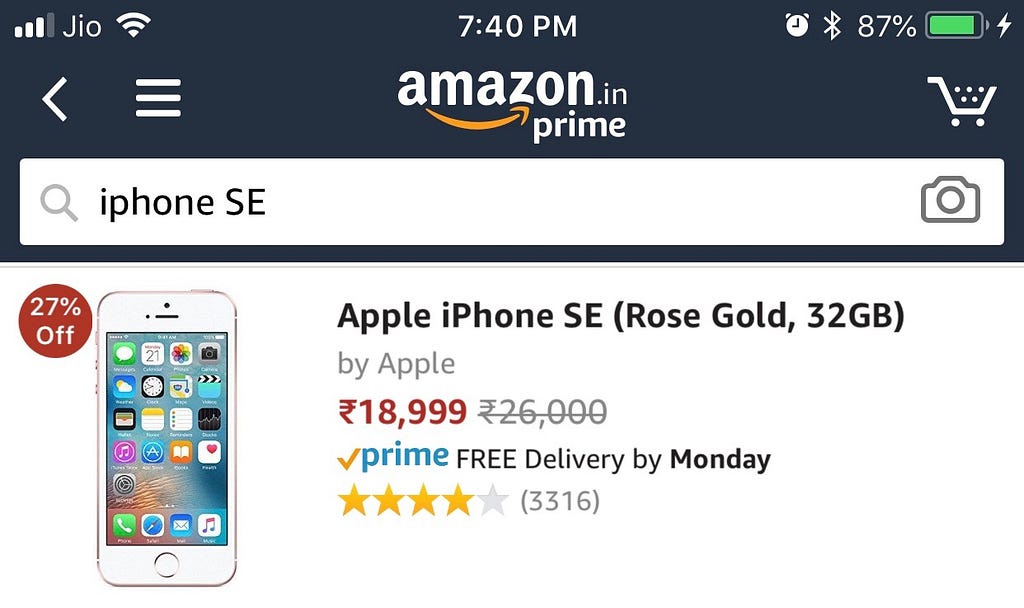 That‘s $279, or $70 less than the US Apple Store price of $349 — you can get it for even less.Old is Gold
That‘s $279, or $70 less than the US Apple Store price of $349 — you can get it for even less.Old is Gold
I just about buy into Apple’s 3-year product replacement cycle on phones. But it’s hard to accept that argument for my iPad, which I use for barely an hour a day. Or my iMac which I feel should last much longer, especially if it’s used mainly for basic writing and surfing, and not for serious photo or video editing. So I have upgraded my phone but keep pushing the envelope on my other devices. My iMac is a 2011 model, and still running smoothly on Mac OS High Sierra though many newer features like Airdrop don’t work on it.
Surprisingly I do have a functional 2008 MacBook Pro, a 17” dinosaur, though it’s running an older OS (I think it’s Mavericks or Mac OS 10.9). I had its battery replaced once. But when the replacement battery ‘bulged’, I just got rid of the thing, effectively converting the MacBook into a laptop. It’s perfectly functional for basic typing and surfing. I often leave it behind at my mother’s place. This way, I have a working large screen machine to use whenever I drop in for a visit. The machine also has some ports that my newer iMac doesn't, which allows me to use it to grab video from my old DV tapes. In short, the old warhorse is still pulling its weight.
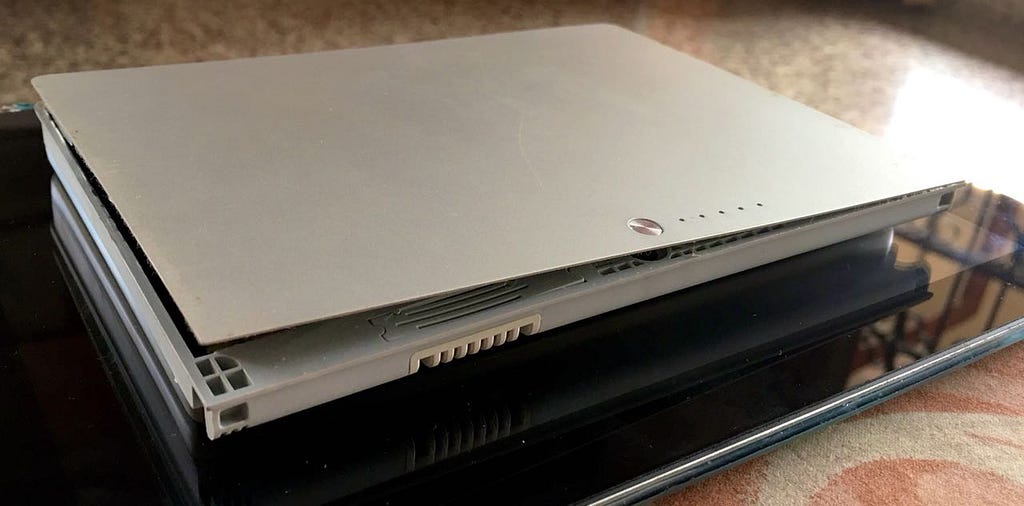 The MacBook Pro battery that bulged (my iPad is acting as a table for it!)Live fast and die young
The MacBook Pro battery that bulged (my iPad is acting as a table for it!)Live fast and die young
As far as my phone goes, it puts in many more hours of work everyday as compared to my iPad. So I don’t seem to be able to extract as much life as I can from my larger devices. When I picked up my iPad 3, I was using the iPhone 4, which I bought around 2010. By 2013, its battery had begun running out fast. I had the battery replaced, but the phone’s ear piece lost power, and I could barely hear calls if I was in a noisy environment like a mall. So when I got a chance for an inexpensive upgrade to a refurbished iPhone 5, I did so. That phone lasted two years till one morning, when its display refused to turn on.
Upset with Apple, I switched to Android. However knowing my love for all things Apple, my wife gifted me an iPhone 6S Plus a couple of months later. I was weary of Android by then, and gladly switched back. That was in December 2015. My iPhone is now in its third year, and isn’t yet obsolete. It does miss features like the back twin camera, and of course, Face ID. But I plan to get a new battery before the year is out (by taking advantage of Apple’s discounted battery replacement program, a response to the phone throttling disaster), and should be able to extract another year from my phone. If I can do that, I will be able to move in directly into the second generation of Face ID phones. I did hear rumours of a larger 6" iPhone, and I may go for that. It will be interesting to see if that reduces my iPad usage.
Reincarnating my iPad
I didn’t like the idea of parting with my iPad as it’s a pretty impressive device despite its age. However its battery condition meant it could drop dead anytime so I had to be practical. Amazon did have an exchange offer for my iPad 3 whilst buying the iPad 6. They were willing to give me ₹1805 ($27) to take it off my hands. Maybe I would get a bit more if I listed it on Quikr or Olx (ebay equivalents in India).
Whatever! It’s still peanuts, and I think my iPad 3 is worth lot more. I mean if my iPad 3 was a non-functional piece of electronic junk, that would have made sense from an environmental pollution point of view.
But this is a functioning iPad that can be used for surfing, viewing media, email, checking bank accounts. It may be slow but it’s an equivalent of a portable PC and video/music player combined. Besides it comes with an all day battery, and a touchscreen, which makes it handy, and easy to use (except for the lack of USB to access pendrives). This thing can easily run a couple of years if you don’t have too many expectations of it in terms of speed.
Disclaimer
The views and opinions expressed in this article are solely those of the authors and do not reflect the views of Bitcoin Insider. Every investment and trading move involves risk - this is especially true for cryptocurrencies given their volatility. We strongly advise our readers to conduct their own research when making a decision.
